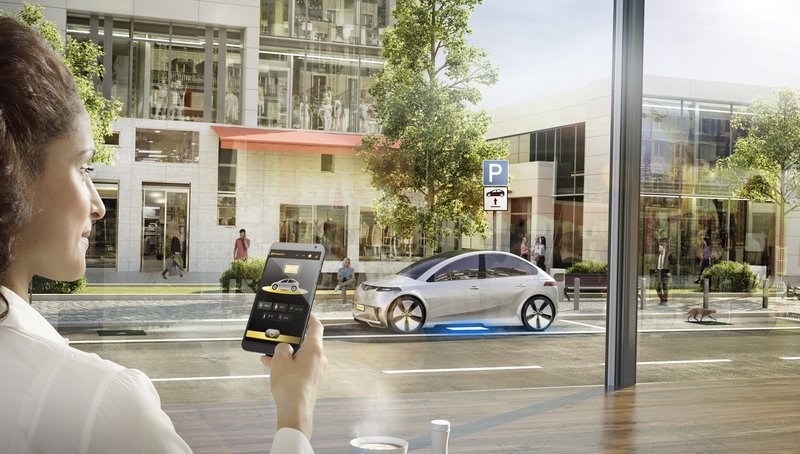Automated Wireless Charging from Continental: Convenient and Efficient
- Continental presents for the first time automated wireless charging solution for EVs
- Convenient charging without cables, improved efficiency
- Inductive charging solution includes vehicle positioning, electronic communication, charging management, safety monitoring and data retrieval
Regensburg, Frankfurt, Hanover, 31. May 2017. At the Continental Tech Show in June and at the IAA Frankfurt Motor Show in September, technology company Continental will be presenting user-friendly inductive charging technology, installed in an electric vehicle. The charging power is transferred wirelessly from a ground-based charging pad to a receiver pad on the underside of the vehicle. All the driver has to do is to park over the charging pad, assisted by an innovative Continental micro-navigation solution. As soon as the vehicle approaches a parking bay equipped with inductive charging, an authentication dialog with the charging station is executed automatically. A human-machine interface shows the driver when the vehicle has reached the correct parking position and confirms that charging has started.
Continental expert Thomas Röhrl, who is a responsible expert for the inductive charging system, explains: “At present, there can be any of a number of reasons why EV drivers are reluctant to use every available opportunity to recharge their vehicle. If it’s cold outside or wet they may not feel like getting out and grappling with the charging cable.” Particularly when drivers only intend to make a short stop, this may all seem like too much trouble and they will prefer to let the opportunity pass by. Continental offers this charging solution not only for EVs but also for e-bikes.
“With the inductive charging system, drivers can take advantage of recharging opportunities whenever they arise, with no hassle whatsoever,” Röhrl continues. “And taken together, a large number of short charging sessions provide just as much energy as one long session.” Since inductive charging involves virtually no effort on the part of EV drivers, Continental expects this to result in an improvement in overall energy balance, and therefore also an increase in the vehicle’s available range at any given time.
More practical charging
EV drivers instinctively tend to compare recharging the battery of their electric vehicle to filling up the tank on a conventional vehicle. The two differences that strike them immediately are first of all the fact that charging an electric vehicle takes longer than filling up with fuel and secondly the fact that before charging can start, they have to connect a cable from the charging station to the vehicle. “We have to make recharging more practical and user-friendly,” says Röhrl. “Inductive charging technology will be a big step towards achieving this.” With this in mind, Continental has developed a comprehensive inductive charging solution capable of recharging the EV at a rate of up to 11 kW. This system charges the vehicle automatically and complete safely as soon as the vehicle is parked in the correct position over the system’s ground pad. The vehicle-mounted inductive charging components comprise a receiver pad, power electronics, controllers and a human-machine interface to assist with precise parking. The positioning system too was developed by Continental. The positioning tolerance of better than 10 cm is ideal to ensure the best possible power transfer from the ground pad to the vehicle. Ongoing progress in the field of semi-automated driving technology will in future allow this aspect of the charging process (parking) to be performed without any action on the part of the driver, making for even greater comfort and convenience. At a charging rate of 11 kW, every minute of charging time provides approximately one kilometer of driving range. “So in the space of a 20 minute shopping trip, the available driving range can be increased by up to 20 km,” says Röhrl.
According to Dr. Oliver Maiwald, Head of Technology & Innovation with Continental’s Powertrain Division: “Continental used its combined cross-divisional know-how to develop this inductive charging solution. Because this type of charging technology requires very extensive and also very focused systems expertise. After all, it spans everything from wireless communication between the vehicle and charging station, sophisticated micro-navigation technology and a human-machine interface providing visual feedback for the driver, to the inductive charging technology itself.”
In addition to its development work on the technical side, Continental is also playing an active role in standardization efforts. As a member of the public-funded German ‘StiLLe’ project (standardization project for inductive charging interoperability / Standardisierung induktiver Ladesysteme über Leistungsklassen) Continental is involved in drafting technical recommendations for the standardization of inductive charging systems.
Inductive charging technology is safe, compact and robust
In addition to convenience, a further feature of this system is its safety. As soon as the wireless authentication process has been successfully completed and the vehicle is correctly parked, the charging pad starts transmitting power. The stepped ramp-up to full output power is completed in just seconds. If the integrated gap-monitoring function detects the intrusion of a foreign object under the vehicle, between the ground pad and the vehicle pad, power transmission is immediately interrupted. Inductive charging technology takes up relatively little space in a garage or parking lot compared with cable-based technology. The ground pad, which is capable of withstanding a load of up to 500 kg, is either located on or recessed into the ground, making the system easier to integrate in confined parking bays than a wall box. In public parking bays (in parking garages or at shopping malls), a further advantage of inductive charging technology is the greatly reduced risk of vandalism.
Click here to download the simple show film “Quickly and easily recharging electric cars”
Click here to download the movie on “Inductive Charging”.

Simone Geldhäuser
Head of Media Relations, Spokesperson Finance, Business and Technology
Vitesco Technologies


